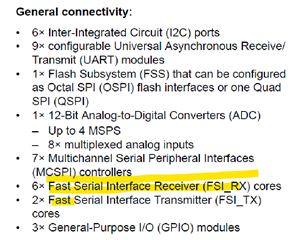Tool/software:
Hi,
Why the number of FSI RX and TX lanes are different (RX 6, TX 2) ?
Is there any specific usecase RX needs more lanes ?
Thanks and regards,
Koichiro Tashiro
This thread has been locked.
If you have a related question, please click the "Ask a related question" button in the top right corner. The newly created question will be automatically linked to this question.
Tool/software:
Hi,
Why the number of FSI RX and TX lanes are different (RX 6, TX 2) ?
Is there any specific usecase RX needs more lanes ?
Thanks and regards,
Koichiro Tashiro
Hi Koishiro, FSI could use up to two RX and two TX lanes. But, could you please shrare with me from where you got this information?
thank you,
Paula
Hi Paula,
The customer just refer to datasheet.
FSI could use up to two RX and two TX lanes.
Do you means only two RX lanes can be used even we have 6 of them (RX0 to RX5)?
Thanks and regards,
Koichiro Tashiro
Hi Tashiro, now I understand better your question.
AM64x has 6 x FSI RX cores and 2 x FSI TX cores.
Each FSI RX core has: 2 RX lanes (RX_D0, RX_D1), and RX CLK
Each FSI TX core has: 2 TX lanes (TX_D0, TX_D1), and TX CLK.
Few more details of FSI signals and connections for one RX and TX core here: [FAQ] MCU-PLUS-SDK-AM243X: How-to test FSI external 1-device loopback on AM243x LP or EVM - Arm-based microcontrollers forum - Arm-based microcontrollers - TI E2E support forums
thank you,
Paula
Hi Paula,
Thanks for the info.
According to the usecase described in the FAQ, TX lanes and RX lanes are the same number (1 to 1 connection).
The customer wonders why AM64x has more RX cores and asks any specific usecase where RX needs more lanes.
Thanks and regards,
Koichiro Tashiro
See https://e2e.ti.com/support/processors-group/processors/f/processors-forum/1369889/am6442-how-many-node-device-can-be-connected-with-fsi-bus-connection-or-daisy-chain and the C2000 FSI app report it has a link to https://www.ti.com/lit/an/spracm3/spracm3.pdf . The asymmetric count of rx and tx is for topologies where a bus/broadcast is used in one direction and a point to point in the other.
Hi Pekka,
Thanks for your reply.
I understood these topologies..
Thanks and regards,
Koichiro Tashiro